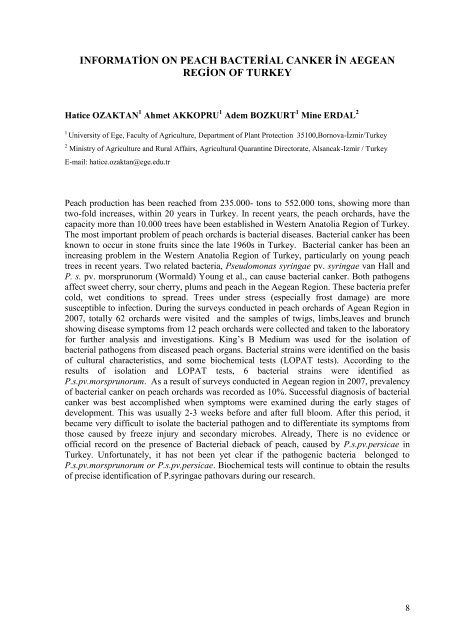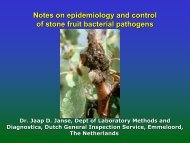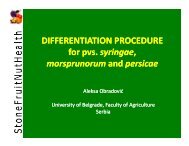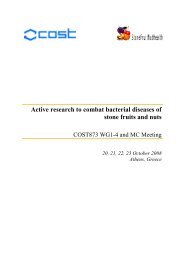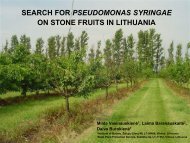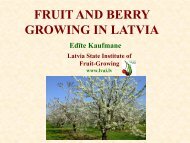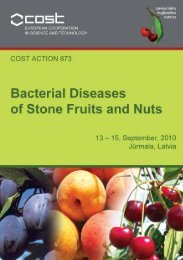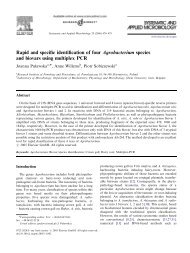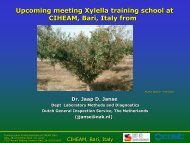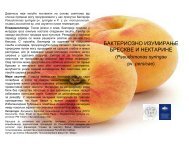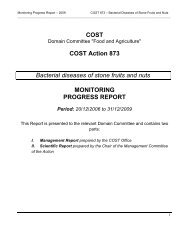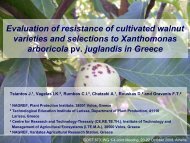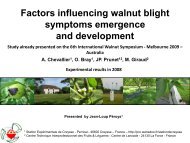INFORMATİON ON PEACH BACTERİAL CANKER İN AEGEANREGİON OF TURKEYHatice OZAKTAN 1 Ahmet AKKOPRU 1 Adem BOZKURT 1 Mine ERDAL 21University of Ege, Faculty of Agriculture, Department of Plant Protection 35100,Bornova-İzmir/Turkey2 Ministry of Agriculture and Rural Affairs, Agricultural Quarantine Directorate, Alsancak-Izmir / TurkeyE-mail: hatice.ozaktan@ege.edu.trPeach production has been reached from 235.000- tons to 552.000 tons, showing more thantwo-fold increases, within 20 years in Turkey. In recent years, the peach orchards, have thecapacity more than 10.000 trees have been established in Western Anatolia Region of Turkey.The most important problem of peach orchards is bacterial diseases. Bacterial canker has beenknown to occur in stone fruits since the late 1960s in Turkey. Bacterial canker has been anincreasing problem in the Western Anatolia Region of Turkey, particularly on young peachtrees in recent years. Two related bacteria, <strong>Pseudomonas</strong> syringae pv. syringae van Hall andP. s. pv. morsprunorum (Wormald) Young et al., can cause bacterial canker. Both pathogensaffect sweet cherry, sour cherry, plums and peach in the Aegean Region. These bacteria prefercold, wet conditions to spread. Trees under stress (especially frost damage) are moresusceptible to infection. During the surveys conducted in peach orchards of Agean Region in2007, totally 62 orchards were visited and the samples of twigs, limbs,leaves and brunchshowing disease symptoms from 12 peach orchards were collected and taken to the laboratoryfor further analysis and investigations. King’s B Medium was used for the isolation ofbacterial pathogens from diseased peach organs. Bacterial strains were identified on the basisof cultural characteristics, and some biochemical tests (LOPAT tests). According to theresults of isolation and LOPAT tests, 6 bacterial strains were identified asP.s.pv.morsprunorum. As a result of surveys conducted in Aegean region in 2007, prevalencyof bacterial canker on peach orchards was recorded as 10%. Successful diagnosis of bacterialcanker was best accomplished when symptoms were examined during the early stages ofdevelopment. This was usually 2-3 weeks before and after full bloom. After this period, itbecame very difficult to isolate the bacterial pathogen and to differentiate its symptoms fromthose caused by freeze injury and secondary microbes. Already, There is no evidence orofficial record on the presence of Bacterial dieback of peach, caused by P.s.pv.persicae inTurkey. Unfortunately, it has not been yet clear if the pathogenic bacteria belonged toP.s.pv.morsprunorum or P.s.pv.persicae. Biochemical tests will continue to obtain the resultsof precise identification of P.syringae pathovars during our research.8
SEARCH FOR PSEUDOMONAS SYRINGAE ON STONE FRUITS INLITHUANIAMilda Vasinauskienė 1 , Laima Baranauskaitė 2 , Daiva Burokienė 11 Institute of Botany, Žaliųjų Ežerų 49, LT-08406, Vilnius, Lithuania2State Plant Protection Service, Sukilėlių 9a, LT-11351, Vilnius, LithuaniaThe area of stone fruits makes up 5515 ha in Lithuania. Plums, sweet and sour cherries aregrown in commercial orchards, small farms and home gardens. Currently, home gardens(from 0.06 ha to 0.5 ha) cover the largest area (3370 ha) under orchards. Future plans arerelated with increasing of commercial orchards in the country, mainly plum and sour cherryplantations.Data on bacterial diseases of stone fruits have been very scarce so far. More attention waspaid to fungal diseases. Common diseases of stone fruits in Lithuania are caused byphytopathogenic fungi such as Monilinia fructigena, M. laxa (brown rot), Chondrostereumpurpureum (silverleaf), Venturia carpophila (plum scab) Blumeriella jaapii (cherry leaf spot).Quarantine Plum Pox Potyvirus (sharka) was recorded in the country as well. However, it hasrecently been revealed the changes in disease dominance that largely depends on alteringenvironmental conditions as well as peculiarities of plants and pathogens. The prevalence ofother pathogens and their harmfulness have not been sufficiently studied yet.<strong>Pseudomonas</strong> syringae is common under climatic conditions of Lithuania and is found onwide range of plants. During previous observations of bacterial diseases in stone fruitorchards bacteria were detected on plum and sweet cherry. The presence of pathogen enablesto focus and conduct research on its biology, distribution and control.Detailed observations of disease in the country were started only in the frame of the project.Survey of stone fruit orchards for possible infection of <strong>Pseudomonas</strong> syringae in Lithuaniawas continued during vegetation season in 2007. Initially the search was focused onoccurrence of bacterial canker on stone fruit trees, evaluation of disease symptoms andpreliminary diagnostic of the causal agent.Leaf samples, injured branches and shoots with susceptible bacterial canker symptoms werecollected in four growth localities of stone fruits from seven observed. After macerationinjured tissue fragments were streaked for isolation on plates with King’s medium B, sucrosenutrient and nutrient dextrose agar media. <strong>Pseudomonas</strong> syringae strains were preliminaryidentified using conventional methods: Gram staining, metabolism of glucose, catalasereaction, LOPAT tests, and serologically.66 isolates from injured stone fruit trees were selected for identification. Most tested isolateswere Gram-negative, catalase-positive. Only 17 of them showed production of fluorescentpigment on King’s medium B and utilized glucose oxidatively, produced levan, had negativeoxidase and arginine dihydrolase activity, were potato rot negative and induced positivereaction of tobacco hypersensitivity.Serological test of immunofluorescence (IF) was performed with P. syringae pv. syringaepolyclonal antiserum (Neogen Europe 1089). Two strains from sour cherry and eight fromplum trees showed positive reaction. The disease was recorded on single trees and did nothave economic importance.Pathogenicity tests with strains isolated from stone fruits and PCR for identification of<strong>Pseudomonas</strong> syringae pathovars and studies of the genetic diversity will be performed.9


